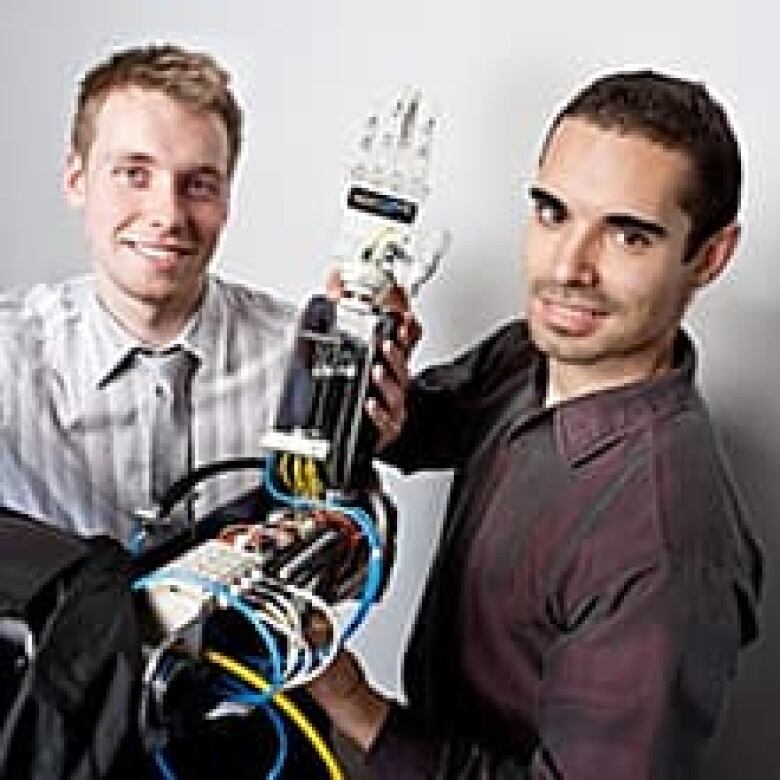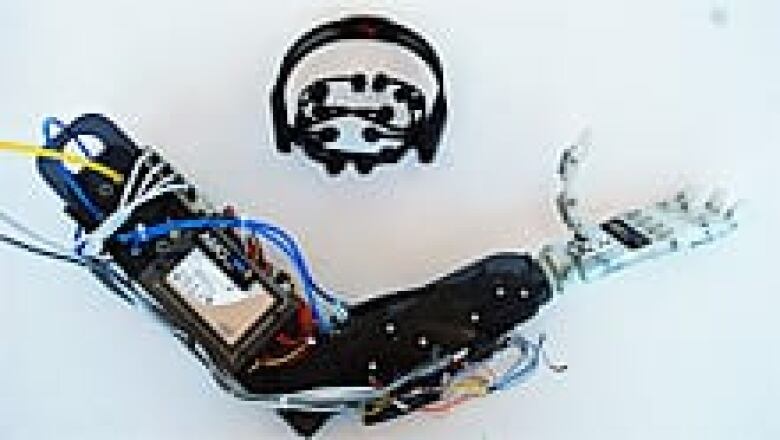Thought-controlled prosthetic arm vies for prize
A prosthetic arm controlled by its user's thoughts, invented by two Toronto students, is competing for funding totake it to market.
The Artificial Muscle-Operated (AMO) Arm created by Ryerson University biomedical engineering students Michal Prywata and Thiago Caireshas a headset that picks up electrical signals from the brain.

The arm can raise and lower at the shoulder and the elbow, rotate its wrist and close its fingers to grasp objects. It is manoeuvred with pneumatic pumps and valves and powered by a small, refillable canister of compressed air in the user's pocket.
Tests show that it takes 10 or 15 minutes to learn to move the arm up and down and close the hand, Prywata said. However, the device has not yet been tested by any amputees.
In June, Prywata and Caires will be the first Canadians to pitch their invention at the American Society of Mechanical Engineers innovation showcase in Austin, Tex.,and compete for seed funding to bring their invention to market.
They hope to sell it for around $20,000. They say other prosthetic arms capable of complex movements often sell for more than $80,000.

The two undergraduates have already founded a startup company called Bionik Laboratories Inc. to commercialize the AMO Arm and other biomedical devices, including other brain-controlled devices and artificial lungs.
The AMO armis considerably more advanced than theplastic arm and hook that most people who have lost their arms are fitted with, Prywata said.
"It's a very simple system and it's like that because when you lose your entire arm, there's no actual muscles to connect any control systems to."
Recently, it has become possible toimplant nerves from a person's arm intohis or herchest through a process called muscle re-innervation anduse that toenable a thought-controlled artificial limb.But the surgery is very expensive and complex so only a handful of people have had it, Prywata said. In 2009,scientists demonstratedthat an artificial armhooked up to a patient's nervous system could allow him tomove an artificial arm and feel sensations in the prosthetic.
No surgery
Prywata said he and Caires envisioned something that didn't require surgery a limb that would be as easy to purchase as a cellphone.
"You lost your arm, you go online, you buy a prosthetic, it comes to your house in a box, you open up the box, you attach it, and you start training."
The two began working on the arm after meeting at a Ryerson engineering open house in the fall of 2009. They spent a year on the software to control the arm, which has since won prizes at the 2011 Ryerson Engineering Competition, the Ontario Engineering Competition and the Canadian Engineering Competition.
They are working to improve the device's ability to adjust its grip for different kinds of objects, such as a fragile raw egg and a heavy water bottle.












_(720p).jpg)


 OFFICIAL HD MUSIC VIDEO.jpg)
.jpg)



























































































